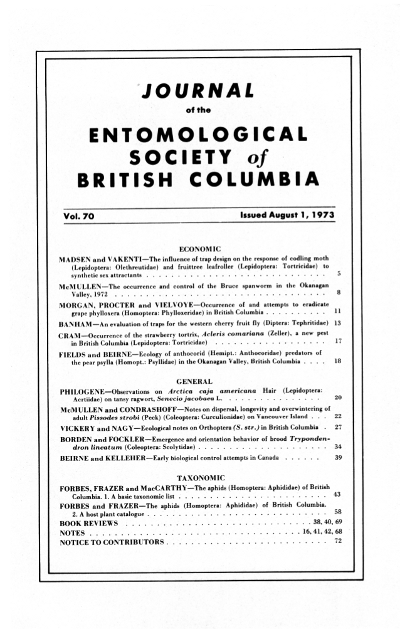Emergence and orientation behavior of brood <i>Trypodendron lineatum</i> (Coleoptera: Scolytidae)
Keywords:
<i>Trypodendron lineatum</i>, Coleoptera, ScolytidaeAbstract
Emergence of <i>Trypodendron lineatum</i> from caged naturally infested host logs occurred from June 2 to August 27, 1969. Approximately 30% of the parent beetles emerged before June 30, when the first major brood emergence took place. The sporadic brood emergence was apparently influenced by maturation, and markedly by environmental temperature, A daily emergence. A total of 6,539 beetles emerged, with a male:female sex ratio of 0.997. Emergent brood beetles were hygronegative and strongly photopositive, indicating that behavioral reversals in both humidity and photic responses must occur since the beetles select and occupy moist, dark overwintering sites.References
Atkins, M.D. 1966a. Laboratory studies on the behavior of the Douglas-fir beetle. Dendroctonus pscudotsugae Hopkins. Can. Ent. 98:953-991.
Atkins, M.D. 1966b. Studies on the fat content of the Douglas-fir beetle. Bi-monthly Research Notes. Can. Dept. Forestry 22(4):3
Atkins, M.D. 1969. Lipid loss with flight in the Douglas-fir beetle. Can. Ent. 101:164-165.
Bennett. R.B. and J.H. Borden. 1971. Flight arrestment of tethered Dendroctonus pseudotsugae and Trypodendron lineatum (Coleoptera: Scolytidae) in response to olfactary stimuli. Ann. Ent. Soc. Amer. 64:1273-1286.
Chapman, J.A. 1960. The distribution of overwintering Trypodendron (Coleoptera: Scolytidae) around a single tree in relation to forest litter variability. Proc. Ent. Soc. B.C. 57:3-6
Dyer, E.D.A. and J.M. Kinghorn. 1961. Facotrs influencing the distribution of overwintering ambrosia beetles, Trypodendron lineatum (Oliv.). Can. Ent. 93:746-759
Fockler, C.E. and J.H. Borden. 1972. Sexual behavior and seasonal mating activity of Trypodendron lineatum (Coleoptera: Scolytidae). Can. Ent.
Graham, K. 1959. Release by flight exercise of a chemotrophic response from photopositive domination in a scolytid beetle. Nature. Lond. 184:283-284.
Graham, K. 1960. Photic behavior in the ecology of the ambrosia beetle Trypodendron lineatum. Proc. 11th Int. Congr. Ent. (Vienna), Vol 2. p. 226.
Hadorn, C. 1933. Recherches sur la morphologie, les stades evolutifs et l'hivernage du bostrych lisere (Xyloterus lineatus Oliv.) Beiheft zu den Zeit Schweizerischen Forstvereins 11. 120 pp.
Janisch, E. 1938. Eber die Methoden zur Konstanthaltung von Temperatur und Luftfeuhtigkeit im biologischen Laboratoriumversuch. Handbuch der biol. Arbeitsmethoden (Aberhalden). Abt. V. Teil 10.1. Vergl Physiol. 3:87-112
Prebble, M.L. and K. Graham. 1957. Studies of attack by ambrosia beetles in softwood logs on Vancouver Island, British Columbia. For. Sci. 3:90-112.
Pulliainen, E. 1965. Studies on the light and humidity reactions of Trypodendron lineatum (Oliv.) (Col., Scolytidae). Ann. Ent. Fenn. 31:197-208
Radinsky, J.A. and G.E. Daterman. 1964. Field studies on flight patterns and olfactory responses of ambrosia beetles in Douglas-fir forests of western Oregon. Can. Ent. 93:1339-1352
Thompson, S.N. and R.B. Bennet. 1971. Oxidation of fat during flight of Douglas-fir beetles Dendroctonus pseudotsugae. J. Ins. Physiol. 17:1555-1563.
Downloads
Published
Issue
Section
License
Authors who publish with the Journal of the Entomological Society of British Columbia agree to the following terms:
-Authors retain copyright and grant the journal right of first publication with the work simultaneously licensed under a Creative Commons Attribution License that allows others to share the work with an acknowledgement of the work's authorship and initial publication in this journal.
-Authors are able to enter into separate, additional contractual arrangements for the non-exclusive distribution of the journal's published version of the work (e.g., post it to an institutional repository or publish it in a book), with an acknowledgement of its initial publication in this journal.
-Authors are permitted and encouraged to post their work online (e.g., in institutional repositories or on their website) prior to and during the submission process, as it can lead to productive exchanges, as well as earlier and greater citation of published work (See The Effect of Open Access).


